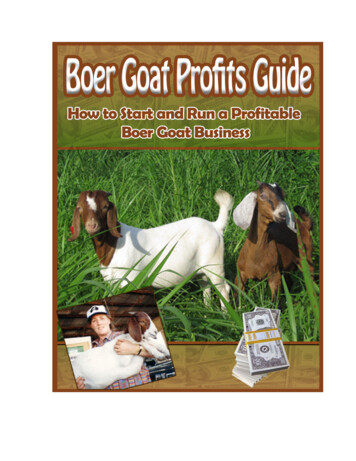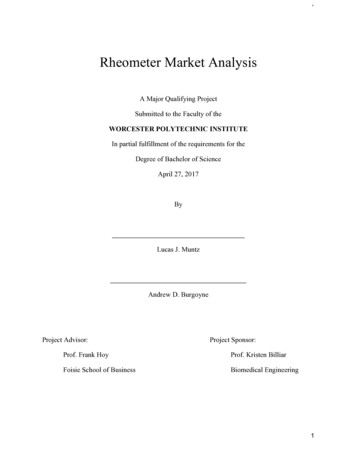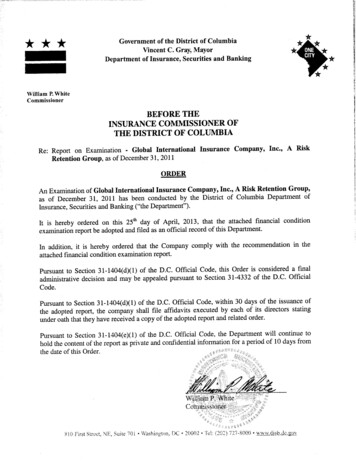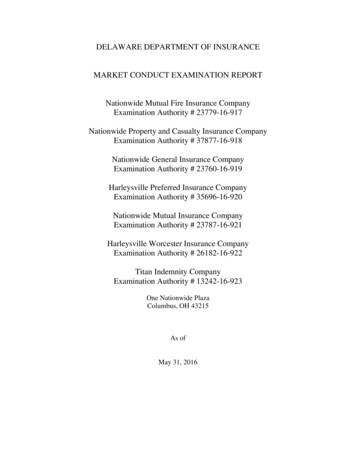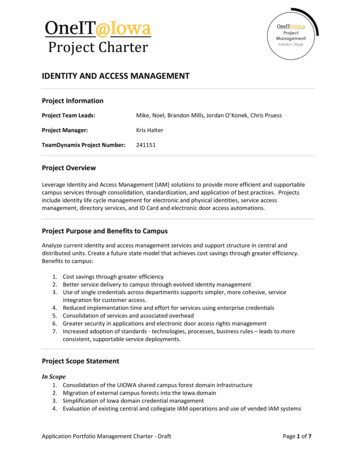
Transcription
BOER GOAT PROFIT GUIDEHow to Start and Run a Profitable Boer Goat BusinessTable of ContentsSection 1:A Quick Background on Boer Goats . .4Where do Boer goats come from?.4When were Boer goats first exported to other countries?.4What is the average lifespan of a Boer goat?.4How much does a full-grown buck/doe weigh?.5Section 2:Benefits of Raising Boer Goats . 5How easy is it to raise Boer goats?.5Are Boer goats easier to raise than other breeds of goat?.6Are Boer goats easier to breed than other goat breeds?.7Are there animals that Boer goats should not mingle with?.8Section 3:How Many Acres Do I Need?. 9What is the best number of Boer goats to raise per acre of grass field?Is it possible to keep Boer goats in a small area (e.g. feedlot) whilestill being productive?.10Section 4:Climate and Soil – What You Need to Know .10What are the best climatic conditions for Boer goats?.10What are the best vegetation and soil-type conditions for Boer goats?Section 5:Profit Potential of Boer Goat Farming . .11How much profit potential is there in Boer goats?.11What are the best marketplaces for Boer goat meat?.15What weight of goat will get the best price at market?.15At what age are Boer goats best for market?.15What are the marketable by-products of Boer goats?.162
Section 6:Starting a Boer Goat Operation – Your First Steps . .17What are the first steps I should take to start a Boer goat productionbusiness?.17When I go to buy my first Boer goats, what should I look for?.19Is there a website that puts buyers in touch with sellers?.22Where could a person find average prices for goats of a particular ageor pedigree?.24Are there any "best practices" in running a profitable Boer goat farm?Section 7:Keeping Your Goats Healthy . 26What are the most common Boer goat health problems?.26What vaccinations do I need to give my Boer goats?.35What should I feed my Boer goats to get the best weight gain?.36Section 8:The Essentials of Breeding . . .38What is the length of pregnancy for female Boer goats?.38What is the best age and weight to breed a doe?.38Will Boer goats breed more than once a year? If so, are there any“tricks” to getting them to breed more frequently?.38What does it mean to “synchronize” the breeding season, and how canI do it?.39When choosing breeding stock, what should I look for?.39What are the most important factors in increasing successful multiplebirths?.41How can I prevent my Boer does from having a miscarriage?.42What treatments must the mother and kids receive after birth?.43Annex A: Boer Goat Business Plan Template .45Annex B: State-Level Boer Goat Associations .543
A Quick Background on Boer Goats1. Where do Boer goats come from?Boer goats were developed in SouthAfrica in the early 1900s for meatproduction, and their name is derivedfrom the Dutch "Boer," meaning“farmer.”Boer goats were probably bred from the indigenous goats of the NamaquaBushmen and the Fooku tribes, possibly with some crossing of Indian andEuropean bloodlines.2. When were Boer goats first exported to other countries?Boer goats first moved from South Africa to New Zealand when embryoswere smuggled out. With embryo transfers, New Zealand's producersincreased herds. Then, Boers were quarantined in New Zealand andAustralia because of scrapie.After they came out of quarantine, ranchers started to export embryos toother parts of the world. South Africa didn’t want their germ plasma to getout, but it did.Now the biggest countries for Boer goat production are the U.S., NewZealand, Australia and southeast China. Germany used to have a larger goatproduction (used mostly for research), and nations like Mexico andArgentina are beginning to farm Boer goats, but on a smaller scale.3. What is the average lifespan of a Boer goat?If you breed them once a year (and keeping in mind that well-bred does havetwins), after 7 or 8 years they are about spent. At that point they tend to havedisease problems, they don’t reproduce anymore and it’s time to get rid ofthem.4
4. How much does a full-grown buck/doe weigh?The weight of a full-grown buck or doedepends on how they’re fed. If you growthem on forage (or if you’re going togrow them with a lot of grain), they tendto weigh more. But on average, thesmallest does can range from 90-100pounds up to 130-140 pounds. Fullgrown bucks weigh more, ranging from150-180 pounds to 190 pounds.If your goats are really pushed to feed on grain, they can become very fat(not a good thing) and weigh even more.Benefits of Raising Boer Goats5. How easy is it to raise Boer goats?Boer goats are survivors, because they evolved in the dry tropics. They’vedevised all kinds of ways to live in a difficult environment where there arenot many foragers but plenty of browse and shrubs. They spend a lot of timebrowsing rather than grazing. And many of their browse plants containnoxious compounds so Boer goats have evolved by devising ways to dilutethese noxious compounds.If you compare a goat to a cow and put them in a grazing situation or givethem a choice, cows are going to eat the same thing most of the day. Goatslike a “buffet.” They like to move from one species of plant to another. Thisis a way for them to dilute some of the noxious compounds they pick up inplants.It’s a common misconception that goats are a lot like sheep – but they areactually quite different. Their nutritional requirements are different. Assmaller animals, goats need better foragers and higher quality feed thansheep.5
6. Are Boer goats easier to raise than other breeds of goat?Boers have mild temperaments, are affectionate, and require no milking, nospecial care and no shearing. Goats in general can survive under adverseforaging conditions, setting them apart from other livestock.Boers, developed for meat and hardiness, are large-framed and resembleNubian goats. They consistently produce more muscling in less time thanother goat breeds.Boers were developed to clear land that was too tough to be cleared byhumans, and they spend a lot more time grazing than other goat types.They're out in the heat of the day when dairy goats stay in the shade, andthey graze in blowing snow. Boers thrive on ground that won't support dairygoats without supplementation.Boer goats in their first 12 months can grow 200 g/day under good pastoralconditions. Faster-growing rates mean Boers reach marketing weights morequickly. (Carcass quality, however, is key to capturing maximum marketreturns.)Boers reach breeding weights fast. They have an extended breeding season,and does can have 3 kiddings every two years. About 50% of does producetwins and another 10% to 15% produce triplets.Boers are good milkers, allowing them to raise multiple offspring withexcellent weight gains, with little pre-weaning mortality.Boer female kids can reach puberty at 6 months of age and are consideredearly breeders. Male kids can be used for breeding at 5 to 6 months of agebut reach puberty or a body weight of 32 kg as early as 3 to 4 months of age.Boer breeders say that their kids are ready for market sooner, and theircustomers will pay a premium for meat goats if they add Boer blood to theirherd.Compared with other goat breeds, Boers put on more weight and generallylook fuller and healthier. At the butcher, if a customer sees a Boer goat alongside another breed, the Boer is often purchased before being butchered.6
Continuous improvement in genetic selection, feeding methods andmanagement systems suggest that growth rates in Boers, as well as theircrosses, will only increase. Because of their desirable traits for meatproduction, Boer goats have raised the performance of indigenous breedsthrough cross breeding so that indigenous goats have seen improvements inbirth weights, growth weights, weaning weights, breeding weights, matureweights, kidding rates and carcass quality.Here are some other reasons why Boers are a great breed to raise: Efficiency of feed and space. With 10 acres, a producer can raise 60 goatsor ten head of cattle. Boers (or Boer crosses) can prosper on poor pasture and brush that wouldnot support cattle. They eat berry bushes, Russian olive, elm orcottonwood trees, ragwort, gorse, dock and other weeds. Some ranchersrun goats on the pasture after their cows--to clean up the weeds. Returns for raising Boer goats are generally higher than for cattle. Youdon't need expensive squeeze chutes for goats, and it's easier to own abuck than a bull and to artificially inseminate a doe than a cow. Many people raise milk goats because they like goats. But it takes lesstime to feed 100 goats than to milk ten. Raising Boer meat goats is anoption to consider if you don't want the trouble of milking, The stress-coping mechanisms of Boer goats are strong and equivalent tothose of hardy Merino sheep. Boers are tame, gentle animals and themore you handle them, the gentler they become. Of course, a widevariation in personalities exists between animals in a herd, and while afew Boers may be flighty, others want to stand and be scratched.7. Are Boer goats easier to breed than other goat breeds?Breeding Boer goats is generally no easier or harder than other breeds,especially since the current herds have much stronger genetics than when thebreed was first brought from South Africa.7
Choosing an exceptional buck and pairing him with average females, andproviding the pregnant does with high quality feed, is generally all that’sneeded to produce strong offspring that will continue to improve the flock.(See the breeding tips in the last chapter of this guide.)8. Are there animals that Boer goats should not mingle with?Given their calm natures, Boers canmingle with just about any animal. Goatsget along fine with chicken and sheep, andare commonly put in the same fencedareas as cows.Because they like different plants (goatsprefer browsing weeds, while cattle grazegrasses), you can put in 1 or 2 goats perhead of beef cattle without reducing the production of your cattle. This is agood way to get a bit more money per acre.You can even put them in with horses. Sometimes the horses will run thegoats a little, but it’s okay with the goats!Goats and sheep share many of the same intestinal parasites and some of thesame diseases, too. But goats and cows have different parasites, anddigesting the other’s parasites will kill the parasite and reduce parasites onthe field.8
How Many Acres Do I Need?9. What is the best number of Boer goats to raise per acre of grassfield?Six to eight goats per acre (plus a fewextra) is a good size, plus the land youuse for other things.In developing your feed budget,budget for 6-8 goats per acre (or in thespring, 4 does plus their kids). Thisassumes that during certain periods ofthe year, you will have to make hay. In the spring, you will have too muchforage. And then, you will have to refeed it in the winter.It’s a good idea to use control grazing, which is shifting fences ten feet everyso often to gradually move the goats across the land once they’ve finished afield.You could also plant different fields with forage and browsing plants thatwork well in different seasons, then do any planting you need once the goatshave moved on to the other field. For example, warm season forages couldbe high quality summer annuals (ex. millet or crab grass) and then in the fall,do small cereal grains. If you can use plants that help fight parasites, that’seven better.You may also want to keep extra land, so that you can store your hay, and sothat if you hit a drought the goats have access to more land, since there isless food per acre in a drought. Extra fields should also be used if you wantto do plant renovation to encourage growth of certain forages, so you can setthat field off use for a season.Alternately, if you have some woods, summer when the summer forage isover (but you don’t want to start on winter feed yet). This is a good time tobrowse your woods.9
In the winter, give animals some shelter and keep it clean of manure, whichcan breed disease. The drier, the better.10. Is it possible to keep Boer goats in a small area (e.g. feedlot) whilestill being productive?Goats are not going to grow on feed inthe same way as beef cattle, sheep, orlamb. Therefore, a feedlot is not an idealenvironment for goats. They are happierand more suited to open browsing, andthey don’t put on enough weight to beworth the money spent on the feed itself.Climate and Soil – What You Need to Know11.What are the best climatic conditions for Boer goats?Boer goats evolved in South Africa and therefore prefer drier climates--asopposed to humid and wet conditions.Boers usually don’t mind the cold, and during winter in both southern andnorthern climates, like Canada, they can be seen outside their shelters, lyingdown--sometimes with frost on their bac
BOER GOAT PROFIT GUIDE How to Start and Run a Profitable Boer Goat Business Table of Contents Section 1: A Quick Background on Boer Goats . .4 Where do Boer goats come from?.4 When were Boer goats first exported to other countries?.4
